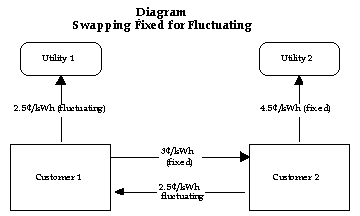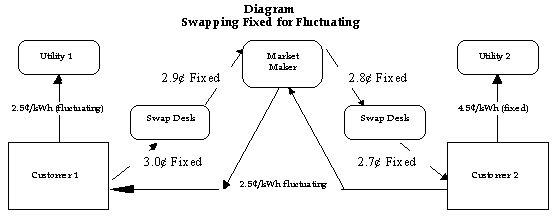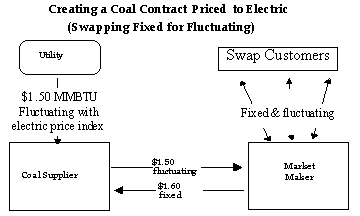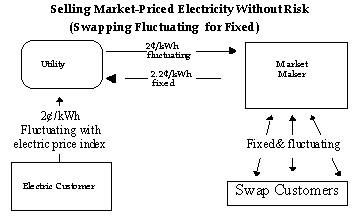| ELECTRIC PRICE RISK
MANAGEMENT USING RATE SWAPS, PRICE INDICES AND MARKET MAKERS by Scott Spiewak
(originally published by PMA OnLine Magazine: 04/98)
The electric industry is rapidly transforming from a regulated
industry in which "ratepayers" receive "tariffs" based upon
"cost-of-service," to a commoditized business in which "customers"
demand "contracts" based upon the best "price."
Price risk management is a key to this transformation. It is accomplished largely by
using four tools: forward contracts, options, swaps and the futures contracts.
Just as transmission access provides liquidity in the physical market, price indices
provide liquidity in financial markets. To understand the critical role of price indices,
consider the plain vanilla swap, a swap of fixed for fluctuating rates, done without price
indices.
Electric Rate Swaps
Electric rate swaps are financial transactions in which an electric customer has its
electric bill paid for by a "counterparty," and in turn pays the counterparty a
fee. The electric customer finds this type of transaction to be attractive in
circumstances in which the originating utility’s cost-based product does not suit its
risk management needs.
For example, a customer which is served by a utility with rates which include a large
fuel cost adjustment mechanism, due to overdependence upon oil or natural gas, may desire
to avoid the inherent exposure to fuel price fluctuations. The customer has a
"fluctuating" rate which it wishes to exchange for a "fixed"
rate—e.g., a rate which is more stable.
Rate swaps are best understood using tables and diagrams. Here is the diagram for a
possible swap between Customers 1 & 2 (Direction of arrows designates direction of
money):

Below is a table which shows the result of a rate swap.
Table 1
Swapping Fixed for Fluctuating Rates

Customer 1 (C1) has as its goal obtaining a fixed rate, and avoiding the vagaries of
its utility’s fuel procurement practices. It accomplishes this by getting Customer 2
(C2) to agree to pay its bill for it. In return, C1 pays C2 three cents per kWh. The
ultimate result is that the 2.5¢ payment to Utility 1 is cancelled out by C2’s
payment, leaving C1 with a 3¢/kWh fixed payment to C2. C1 has accomplished its goal of
rate stabilization.
Customer 2 has the goal of getting an immediate rate reduction, with the possibility of
future rate reductions should the cost of generating power fall. It accomplishes this by
enticing C1 to pay it a premium rate in return for rate certainty— C1 pays 3¢,
reducing C2’s fixed costs to only 1.5¢/kWh.
Of course, C2 has to pay C1’s variable-rate electric bill, but that is only 2.5¢
currently. Add the 1.5¢ fixed payment and the 2.5¢ variable payment and C2 is still only
subject to a current charge of 4¢/kWh. C2 has an immediate savings of .5¢/kWh, and the
possibility of additional savings should the cost of production for Utility 1 fall in the
future.
In order to accomplish this transaction, the counterparties had to not only be made
comfortable with each other’, but also with the fluctuating measure (Utility 1’s
cost of production). Documenting and making the customer familiar with that fluctuating
measure has taken months. Even then, there may be disputes regarding the measure, and it
is subject to the vagaries of a single company’s operations. Finally, it is almost
impossible to find customers who are perfect matches—who are willing to trade a
customized fluctuating measure in the exact same quantities during the same time frame. In
practice, many "nubs" are left on the deal.
Price indices create the conditions for solving most of these problems. By
standardizing the fluctuating measure, price indices permit there to be created a market
in price swaps. Rather than identifying a counterparty for each transaction, familiarizing
each with the vagaries of the custom price measure, and dealing with transaction nubs,
customers can deal with market-makers. Market makers establish prices for swapping the
index, and handle many transactions, quickly and cheaply.
Liquidity in Financial Markets
With the DJ-COB index in place, the electric price swap market is beginning to look
like this:

Freedom to Focus on Core Competencies
Rather than the one-on-one transactions we have had to do in the past several years,
market-makers make it possible to do many transactions without perfect matches among
customers.This vast increase in liquidity is permitting new rate products to be created
which allow companies to focus on their core competencies, such as running powerplants
well.
Example: Coal priced to electricity
For example, many utilities are moving away from long-term fixed price coal supply
contracts. These contracts have often resulted in power costs which are
"out-of-the-market," even though the powerplant is running well.
An ideal solution to this problem is a coal supply contract which is priced indexed to
electricity. That way, if electric prices fall, coal prices fall. If electric prices rise,
coal prices rise. In either case, so long as the plant is run well, the power company will
continue to make a profit.
Without electric price indices, it is very difficult (and expensive) for a coal company
to offer coal at prices marked to electricity. One has to establish what the measure is
and gain confidence that it can’t be manipulated. With an electric price index in
place, it is a relatively simple matter to offer coal at electricity-based prices. The
transaction looks like this (arrows show direction of money):

The Utility pays the Coal Supplier a rate which fluctuates with electric rates. The
Coal Supplier "swaps" that "fluctuating" payment stream for a
"fixed" payment stream through a price market-maker. The market maker is
continually swapping fixed for fluctuating based upon the index, and so can readily name a
price for doing the swap. It is the broad use of the index by a variety of customers which
makes it possible to be a market maker.
Example: Selling electricity at "market rates" without risk
Increasingly, electric power customers will be seeking electric suppliers which are
willing sell at the "market price." Indices provide not only the basis for
determining that market price, but a means of hedging the risk associated with such an
offer. The customer wants market-based rates. The power company needs to cover the fixed
costs associated with power production. These wants and needs can be reconciled through
the use of price indices:

In this case the Utility receives a "fluctuating" payment stream from the
customer, based upon the "market price" of electricity. But because that market
price is based on an index, it can be easily "swapped" for a fixed rate with a
market-maker.
Conclusion
The establishment of reliable indices is not a trivial matter. In the natural gas
industry, for every dollar spent on natural gas product, there are ten dollars worth
financial transactions based upon natural gas. Presuming the same ration holds with
electricity, we can expect financial transactions with a notional value in excess of a
trillion dollars each year in support of electric price risk management. The efficiency
and viability of this market depends in large measure on the reliability of the price
indices established by such firms as Dow Jones. |
